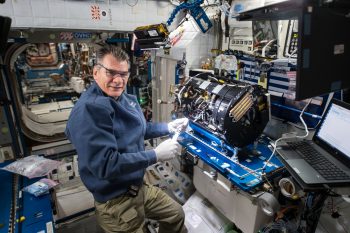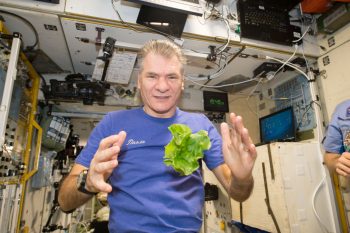With ESA astronaut Paolo Nespoli having passed his 100-day in space-mark, we are long overdue with a look at what science he has been doing on the International Space Station.
We will continue from our last science blog entry that ended on the week of 11 September with the arrival of the new crew on Soyuz MS-06.
SpaceX Dragon CRS-12 was released on 17 September and October saw three spacewalks that required many hours to prepare, both on ground and in space.
A second session of Sarcolab was run with three subjects taking part. Sarcolab uses the Mares installation to monitor how muscles behave in space. Mares is a precision workout machine that can apply pressure to the muscles as well as record exerted strength. Sarcolab-3 will take this data and combine it with samples from the astronaut’s muscles before and after flight together with MRI and ultrasound tests to get a complete picture of how muscles change in weightlessness.
The MagVector experiment is looking at how Earth’s magnetic field influences electrical conductors and two more runs collecting data on the Space Station’s hardware were completed. Extremely sensitive magnetic sensors are placed around and above a conductor with data recorded to a USB stick for later analysis.
The long-running Space Headaches experiment continues and gained new subjects with the crew that arrived on the Soyuz spacecraft. Space Headaches sees astronauts filling out simple questionnaires to gather information on headaches they suffer in space. Many astronauts mention headaches that pass after a few days but researchers are keen to know more.
Paolo and others reported on their sleep to assess how new LED lights on the Space Station are affecting them as they are replaced by older fluorescent light bulbs.

ESA astronaut Paolo Nespoli working on the Space Station combustion rack. Credit: ESA/NASA
Paolo also started preparing the Combustion Integration Rack that will see five different studies on burning gas flames in space. Contained in a closed-off rack to avoid any safety problems, the studies aim to improve fuel efficiency and make fuels more environmentally-friendly.
Another two 36-hour recording of Paolo’s data for the Circadian Rhythms experiment took place. The patch on Paolo’s forehead in some pictures he has posted on social media is recording his body temperature to assess his biological clock. The Space Station astronauts have no natural 24-hour cycle as on Earth, instead sunlight lasts 45 minutes per half-orbit of Earth and they live for months in artificial light. Studying how astronauts’ adapt will help understand our biological clock and help people on Earth who work and live irregular hours.
ESA’s MobiPV project was checked and confirmed running as planned by exchanging pictures, notes and video feed with ground control. MobiPV aims to improve how astronauts handle complex tasks by allowing ground control to see what the astronaut sees as well as show the astronaut what steps to take without having him or her look away from their task at hand. A real test where Paolo will do some maintenance work is planned.
Paolo continues to take part in the Canadian At Home In Space experiment. It is collecting information on how Space Station astronauts feel about their house that orbits our planet. Cultural and social aspects are being taken into account to help designers consider how humans interact and cope with isolation and stress for the next generation of spacecraft.

ESA astronaut Paolo Nespoli and the latest Veggie experiment harvest. Credit: ESA/NASA
A third Veggie session was started and harvested, growing lettuce in space in three weeks. This NASA greenhouse is growing red romaine, mizuna and green lettuce in space in the European Columbus laboratory.
Europe’s ElectroMagnetic Levitator was prepared for a run that lasted a week in October. The device allows alloys to be melted and cooled in mid-air and observed. The facility can be pumped with pure gas depending on the experiment requirements.
The Kubik incubator-centrifuge was given some love with its temperature sensors calibrated and checked. ESA’s Kubik facility allows for biological experiments to be incubated and stored automatically. It was put away ready for its next experiment.
The PK-4 equipment also got a dust down. The joint Roscosmos-ESA experiment observes ionised gas with dust particles that react as atoms would do on an atomic scale. The machine allows for researchers to see and observe how atoms behave. The facility was maintained by cleaning of pumping of the gas used.



Discussion: no comments